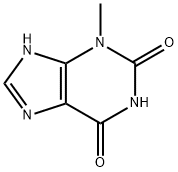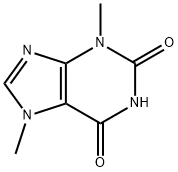3-Methylxanthine , 10mMinDMSO , 1076-22-8
Synonym(s):
2,6-Dihydroxy-3-methylpurine;3-Methylxanthine
CAS NO.:1076-22-8
Empirical Formula: C6H6N4O2
Molecular Weight: 166.14
MDL number: MFCD00005580
EINECS: 214-058-1
| Pack Size | Price | Stock | Quantity |
| 1ml | RMB159.20 | In Stock |
|
| others | Enquire |
PRODUCT Properties
| Melting point: | >300 °C (lit.) |
| Boiling point: | 294.33°C (rough estimate) |
| Density | 1.4434 (rough estimate) |
| refractive index | 1.6700 (estimate) |
| storage temp. | 2-8°C |
| solubility | DMSO (Slightly, Heated), Methanol (Slightly) |
| form | Solid |
| pka | pK1:8.10;pK2:11.3 (25°C) |
| color | White to Pale Beige |
| Water Solubility | Insoluble in water. |
| BRN | 180944 |
| InChIKey | GMSNIKWWOQHZGF-UHFFFAOYSA-N |
| CAS DataBase Reference | 1076-22-8(CAS DataBase Reference) |
Description and Uses
3-Methylxanthine is one of the metabolites of theophylline. After oral intake, approximately 36% is excreted in the urine as 3-methylxanthine, 40% as 1,3-dimethyluric acid and 17% as 1-methyluric acid. 3-methylxanthine (3MX) has been assessed as an adenosine antagonist and produces the same maximal relaxation of guinea pig tracheal muscle as does. 3MX is also used to examine conformational heterogeneity in RNA aptamers and riboswitches[1-2].
3-Methylxanthine is a Xanthine derivative with diuretic, cardiac stimulant and smooth muscle relaxant activities; isomeric with theobromine.They can also act as Bronchodilator.
Safety
| Symbol(GHS) |  GHS07 |
| Signal word | Warning |
| Hazard statements | H302 |
| Precautionary statements | P301+P312+P330 |
| Hazard Codes | Xn,T+ |
| Risk Statements | 22-26/27/28 |
| Safety Statements | 22-24/25 |
| WGK Germany | 1 |
| RTECS | ZD8750000 |
| HS Code | 29335990 |
| Toxicity | LD50 intraperitoneal in mouse: 894mg/kg |




![3,7-Dihydro-3,7-diMethyl-6-[(5-oxohexyl)oxy]-2H-purin-2-one](https://img.chemicalbook.com/CAS/GIF/93079-86-8.gif)
![1,1'-[(5E)-5-Methyl-7-oxo-5-undecene-1,11-diyl] Bis](https://img.chemicalbook.com/CAS/GIF/874747-30-5.gif)